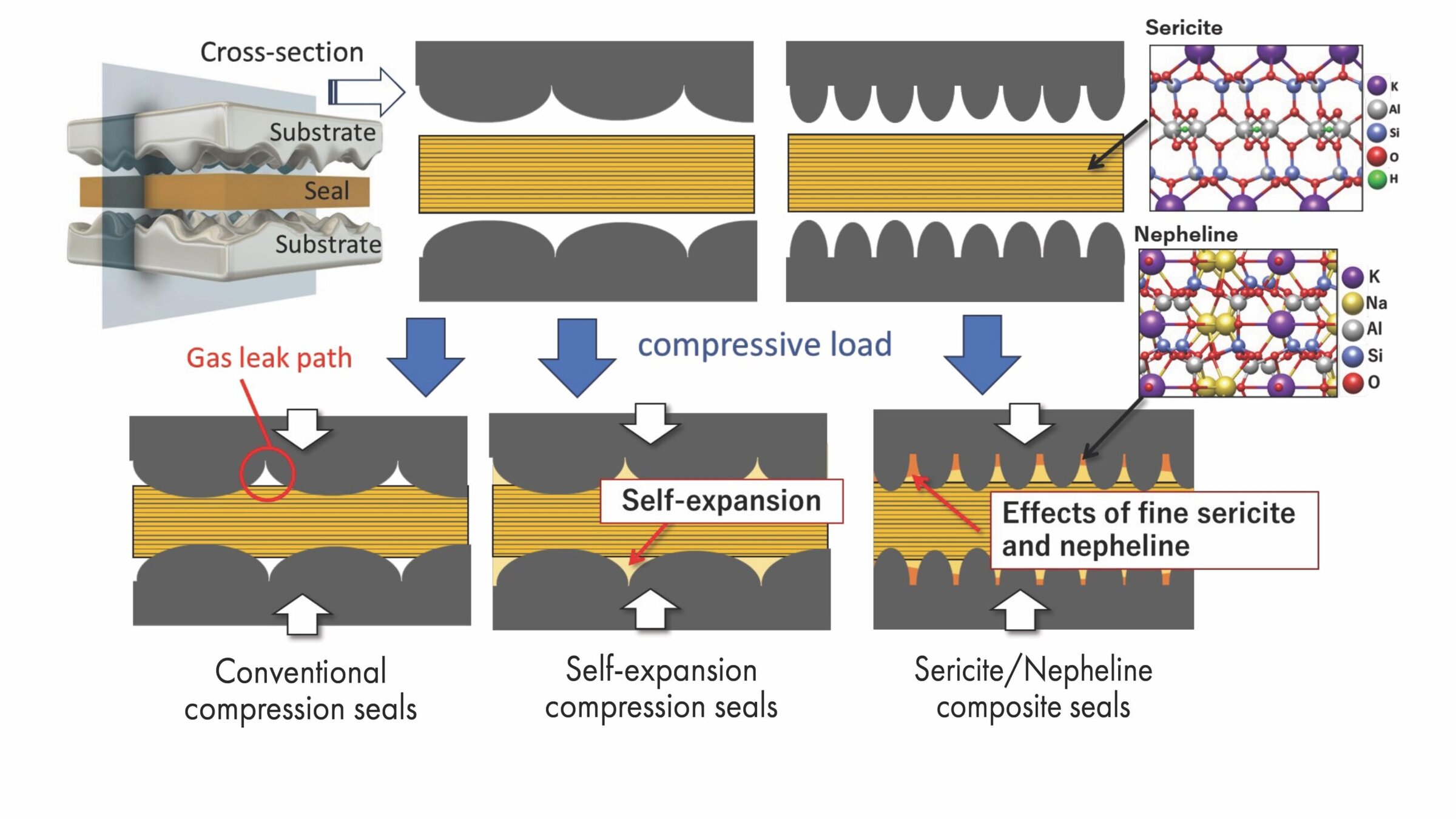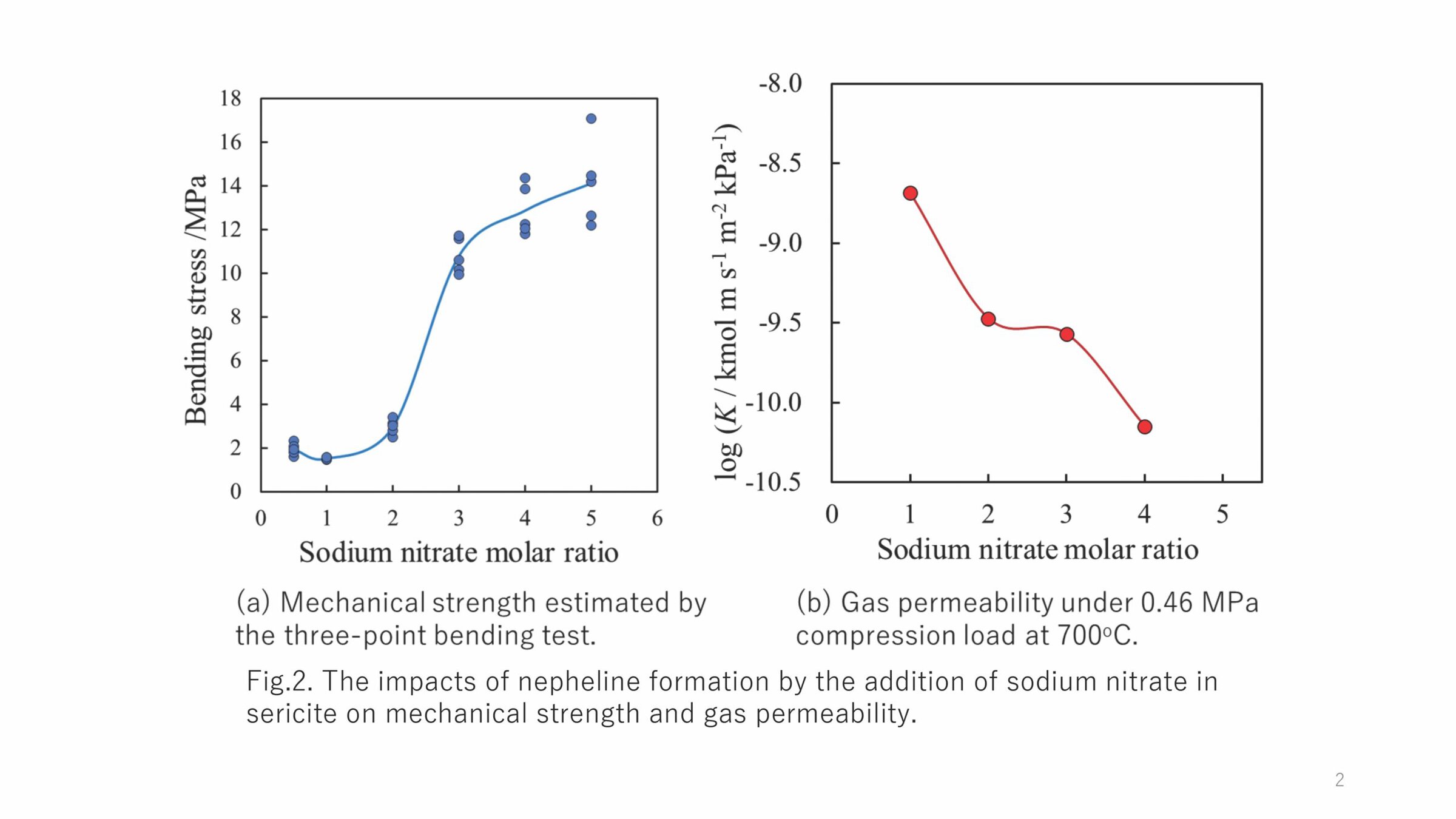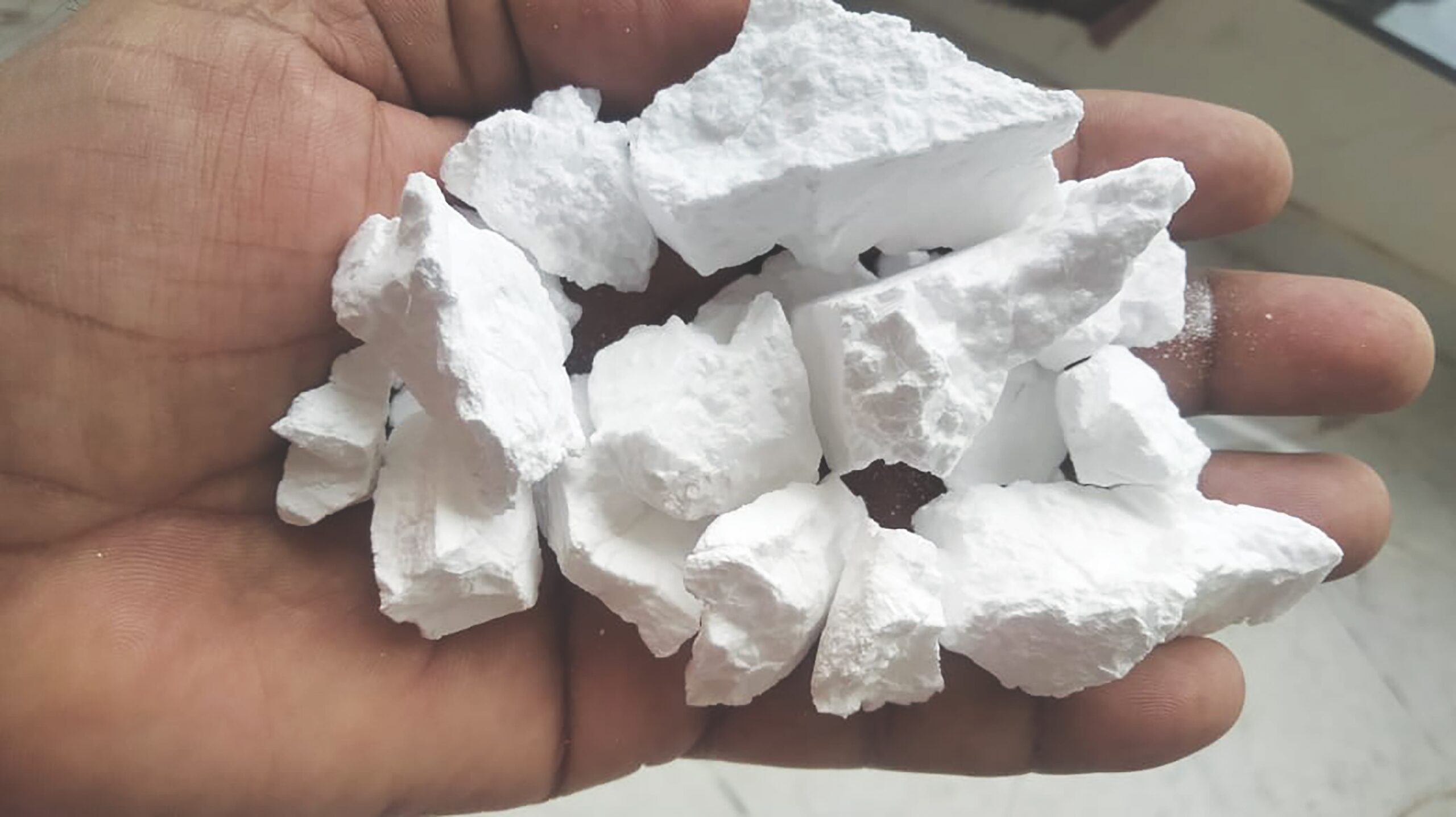Both solid oxide fuel cells (SOFCs) and solid oxide electrolysis cells (SOECs) require reliable gas seals that are durable at high temperatures and stable in hydrogen environments.
Glass-based materials typically exhibit excellent gas sealing properties at elevated temperatures. However, they encounter significant durability challenges under rapid thermal cycles and vibrations, both of which pose barriers to the installation of glass-sealed SOFCs in mobile systems.
In contrast to traditional glass-based gas seals, glass-free gas seals made from clay materials perform well under vibrations due to their high elasticity. Thus, the development of advanced clay-based gas seals represents a promising research area for rapid start/stop working systems and vehicles.
To ensure an adequate gas barrier, gas seals must handle both a substantial load and achieve a high degree of contact with adjacent materials. My group is developing self-expanding sericite-based compression seals to fulfill both requirements.
Benefits of clay minerals for self-expansion compression seals
Clay minerals with layered structures are increasingly recognized as critical raw materials for compression seals. These minerals exhibit significant anisotropy and irreversible expansion during processing, as the interlayers open widely when dehydrated during heating.1 For example, vermiculite irreversibly expands multiple times in the vertical direction of each layer when heated to 700°C.
Compression under moderate tightening loads tends to create small gaps at the interface between adjacent materials and the seals due to the uneven material surfaces. The self-expansion inherent to clay minerals effectively fills these gaps within the seals, significantly reducing gas leakage at the interface.
The processing conditions of clay materials greatly influence the degree of irreversible expansion. Proper calcination at temperatures lower than the operating temperatures of SOFCs/SOECs achieves a balance between excellent elasticity and self-expansion during heating at the operating temperature.2
Sericite-based compression seals
We focused on using the layered clay sericite (KAl3Si3O10(OH)2) as a compression seal for two reasons: its promising insulating properties in a reducing atmosphere and its fine particle sizes.
Sericite contains lower concentrations of transition metal elements compared to other clays. These low concentrations mean that sericite can maintain high electrical insulation even in a highly reducing atmosphere at elevated temperatures.
As noted in the previous section, the self-expansion of clay minerals allows the seal to conform to microscopic surface irregularities. Clay minerals that feature fine particles enhance the sealing properties because the layered fine particles will help fill the very small gaps (Figure 1).

Figure 1. Schematic illustration of the promising advantages of self-expansion compression and sericite/nepheline composite gas seals. Credit: Seiichi Suda
Layered clays typically consist of coarse particles, and pulverization processes are necessary to obtain fine particles with layered structures. This pulverization significantly reduces the irreversible expansion and self-expansion properties of the clay because it disrupts the layered structure. Fortunately, high-purity sericite naturally forms under hydrothermal conditions and contains fine particles. Only deagglomeration processes that maintain the layered structure are necessary to obtain fine sericite particles.3
Sericite, like other layered clays, demonstrates irreversible anisotropic expansion during processing. This irreversible expansion is essential for achieving high gas sealing performance. However, clay minerals may also experience reversible thermal expansion during thermal cycling in operation, and this behavior plays a vital role in the long-term durability of the sealing material.
To evaluate the reversible thermal expansion of sericite, we measured the temperature dependence of the lattice constant using high-temperature X-ray diffraction.4 The linear expansion coefficient indicated that the reversible thermal expansion of sericite closely correlates with that of typical SOFC electrodes and electrolyte materials, meaning adequate contact will be maintained between the seal and adjacent materials during cycling. Thus, sealing materials primarily composed of sericite can be used for SOFC and SOEC applications.
Potential of sericite/nepheline composites
Despite its advantages, the low mechanical strength of sericite poses a significant challenge to its use as a novel compression seal. Fortunately, the addition of sodium salt to sericite-based seals can notably improve mechanical strength due to the formation of nepheline.
Nepheline is a type of silicate mineral that forms in sericite when heated with sodium salts. It acts as an adhesive between sericite particles and layers, significantly enhancing mechanical strength. Nepheline can also help enhance gas sealing properties at high temperatures because it forms after undergoing a liquid phase. This transient liquid phase allows it to fill the remaining interfacial gaps that were missed by the self-expansion of sericite. Figure 2 shows the impacts of nepheline formation on mechanical strength and gas permeability of the sericite-based compression seals.4

Figure 2. Impacts of nepheline formation on a) mechanical strength (estimated by the three-point bend test) and b) gas permeability (0.46 MPa compression load at 700°C). Credit: Seiichi Suda
In addition to conventional evaluation of the seal’s gas permeability (Japanese Industrial Standards R 1761), we separately evaluated the seal’s internal gas permeability coefficient, which is derived from the gas permeation path inside the sealing material, and the interfacial gas permeability coefficient, which is derived from the gas permeation path along the interface with the adjacent materials. We determined that the formation of nepheline improved both internal gas permeation and interfacial gas permeation.
The optimization of nepheline is essential to enhance the gas sealing properties of the sericite/nepheline composite. Fortunately, the properties of nepheline can be regulated by substituting alkaline metals contained in the nepheline with other cations via solid solution methods. We found that the addition of potassium significantly improved gas permeation not only from the inside of the seal material but also at the interface.
Future of sericite-based compression seals
Reliable gas seals are needed for next-generation SOFCs and SOECs. This study showed that the thermal properties of sericite-based compression seals are suitable for this purpose. Additionally, the formation of nepheline in sericite-based compression seals via sodium salt doping enhances the sealing properties. Future studies will explore how the sealing performance can be further improved by combining it with suitable additives that modify the properties of the base sericite and nepheline.
Cite this article
S. Suda, “High-temperature gas sealing properties of sericite-based self-expansion compression seals,” Am. Ceram. Soc. Bull. 2025, 104(6): 52–53.
About the Author(s)
Seiichi Suda is professor of materials science and engineering at Shizuoka University, Japan. Contact Suda at suda@shizuoka.ac.jp.
Issue
Category
- Energy materials and systems
- Structural clay products
Article References
1M. Rautanen et al., “Effects of the first heat up procedure on mechanical properties of solid oxide fuel cell sealing materials,” Journal of Power Sources 2015, 284: 511–516.
2J. Xu and S. Suda, “Effects of composite ratio of vermiculite/talc seal material on gas leak properties,” Proc. 42nd Int. Conf. on Adv. Ceram. Composites 2019, 39(2).
3“Sanshin Mining’s sericite products,” Sanshin Mining Ind. Co., Ltd. Accessed 17 June 2025.
4Y. Abo and S. Suda, “High-temperature gas sealing properties of sericite-based self-expansion compression seals.” Poster presented at the 49th International Conference and Exposition on Advanced Ceramics and Composites, January 2025.
Related Articles
Bulletin Features
Sintered synthetic cristobalite: Innovative kiln-based thermal transformation of quartz
Cristobalite, a high-temperature polymorph of silica, is widely used in ceramics, glass, paints, refractories, and dental materials due to its low density, high whiteness, thermal expansion behavior, and mechanical stability. Traditional cristobalite production methods rely on static sintering of finely ground quartz at high temperatures (~1,750°C) for extended durations (2–3…
Market Insights
Bioactive glass continues to transform medical care decades after first hitting the market
Almost 60 years ago, a chance meeting led to pioneering work that has improved medical care and seeded future innovations. In the late 1960s, a young professor named Larry Hench traveled to a conference in Sagamore, N.Y., where he happened to sit next to a U.S. Army colonel who was…
Market Insights
Sustainable development and design: Inspiration from landscape-shaping creatures
Animals are not just passive inhabitants of their environment. Many are architects of the natural world, actively shaping landforms and water bodies as they move around, feed, build homes, and reproduce. This impact by animals on different biomes has traditionally been overlooked in the environmental sciences. But scientists and engineers…




